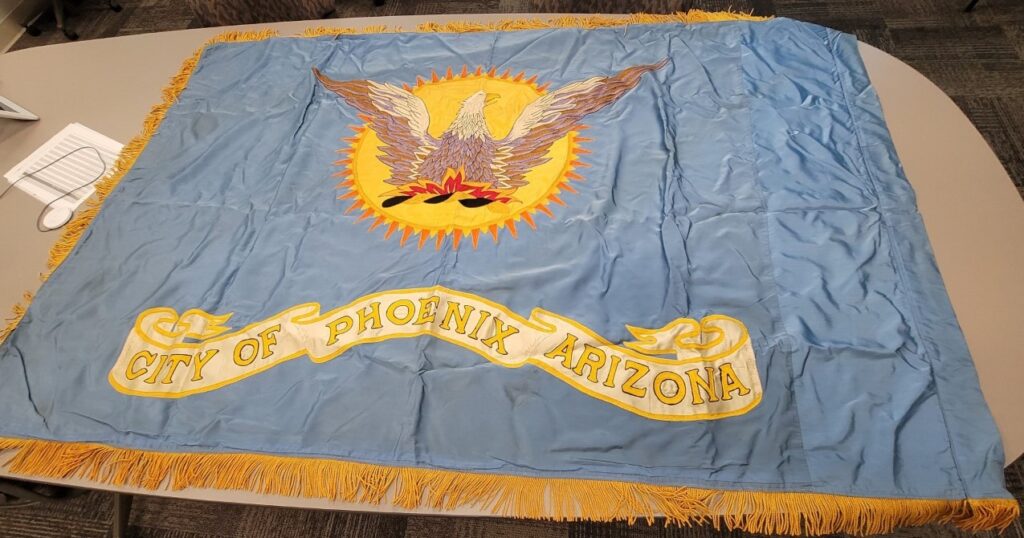Donna Reiner, has written many articles over the years for the Arizona Republic and others about Phoenix history and memorials. She is a regular contributor to our newsletter. This month, Donna tells us about the Phoenix city flag, which turns 100-years old this month.
Get a group of historians and history buffs together to look at old Phoenix pictures and then try to outwit each other with trivia questions, one is apt to come away with a few story ideas. This is one of those stories.
There had been talk by the state historian, James McClintock, about a flag for the city of Phoenix. And a tourist even remarked that the motto should be “The Miracle City” rather than “Phoenix Rises.” That tourist thought Phoenicians simply did not appreciate their ability to create a Garden of Eden in the desert.
One hundred years ago this month, a group of women members of the chamber of commerce, led by Maie Heard, took the idea of having a Phoenix city flag to the next step. No more talking or discussion. Instead, these women instituted a competition for the design. While there were purported to be guidelines, none were discovered except for the recommendation that “the colors of the flag harmonize with those of the national emblem.” Maie Heard offered a prize of $25 for the winning entry.
A popular contest, the chamber of commerce received hundreds of entries and finally selected one. Frederick C. Green, Sr., a mining engineer was declared the winner since the first place drawing was too elaborate.
In order to become “official,” the Commission of the City of Phoenix needed to approve an ordinance making it so. Ordinance #544 described the flag as a “Phoenix Bird in grey on Gold Sunburst Background on a Blue Ground. [A] White Ribbon Scroll along [the] lower part of [the] Flag on which is the following legend in Gold: ‘CITY OF PHOENIX, ARIZONA.’” The 48 rays of the sun represent the 48 states (some rays are hidden by the Phoenix’s wings) and gold fringe trimmed three border sides.
The ordinance was unanimously approved November 23, 1921. Mayor Willis Plunkett also mentioned that the flag would cost $175, and all the commissioners approved the expenditure.
On November 11, 1921, the silk taffeta flag was exhibited for the first time as part of the Armistice Day parade. And then……no mention is made of the flag until 1929, after the city had moved into the new city hall (now Historic City Hall).
The flag, having been “hidden in a musty vault at the old city hall,” was “rescued from oblivion” and prominently displayed in the commission chambers. For some Phoenicians, it was the first time they had seen it or even knew that such a flag existed. But times changed, and once again the flag disappeared from public view.
Out of sight, out of mind. A piece of Phoenix history was hidden again. However, a new flag design was adopted in 1990.
Coincidentally, that original flag was discovered by one of those history buffs in the city clerk’s vault in the current city hall. While not being stored up to museum standards, especially considering its age, the flag is a gem. Perhaps we can persuade the mayor and city council to put it back on display, at least for its 100th birthday in November.











